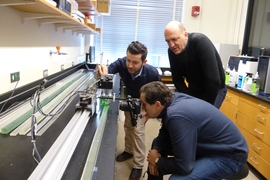Road vehicles are a key part of the climate change challenge, representing both an important source of petroleum demand and greenhouse gas (GHG) emissions worldwide. Changes to our transportation system — how much we travel, the vehicles we use, and the fuels that power them — offer the potential for substantial reductions in GHG emissions, and are necessary to mitigate climate change. Likewise, changes in policy, driving behavior, and the development of alternative fuels and energy sources are required to meet this challenge.
"On the Road Toward 2050: Potential for Substantial Reductions in Light-Duty Vehicle Energy Use and Greenhouse Gas Emissions," a new report spearheaded by MIT professor of mechanical engineering John Heywood, identifies three important paths forward for light-duty vehicles (LDVs, i.e., cars and light trucks): improve the existing system and technologies for shorter-term benefits; conserve fuel by changing driver habits for nearer- to longer-term benefits; and transform the transportation system into one that is radically less carbon-intensive for longer-term benefits. Each element is separately important, but must collectively be pursued aggressively to achieve necessary emissions reductions. More research, development, and demonstration studies are needed to lay the foundation for such a long-term transformation.
The report addresses topics related to the evolution of vehicle technology and its deployment, the development of alternative fuels and energy sources, the impacts of driver behavior, and the implications of all of these factors on future GHG emissions in the United States, Europe, China, and Japan.
In the United States, LDVs alone currently account for 43 percent of petroleum demand and 23 percent of GHG emissions, when fuel production is considered. The United States, Europe, China, and Japan consume over half of the world’s petroleum, making these countries particularly critical in efforts to reduce petroleum consumption and the associated emissions.
“Overall, we have substantial opportunities for reducing environmental and climate impacts from light-duty road vehicles,” said Heywood. “Achieving reductions in vehicle-related greenhouse gas emissions will require a major global shift towards more efficient personal and freight vehicles — including those powered with alternative, low-carbon energy sources — along with a corresponding reduction in demand for energy-intensive vehicles that is strongly incentivized with supportive policies, and ongoing research towards the technology breakthroughs needed to achieve a transition to a truly low-carbon transportation system.”
The results of the report’s plausible yet aggressive scenarios for the United States show the potential for technological improvements to more than offset fleet growth and, by 2050, reduce fuel use and GHG impacts by up to 50 percent. In Europe, the anticipated fleet growth is less, as are the potential reductions from technology improvements, but the overall percentage reduction potential is similar to that in the United States. In Japan, fleet size and use are declining, so the overall reduction in impacts could be larger. In China, though current growth in fleet size is large, reductions in that growth rate and substantial technology improvements over time are expected to level off fleet fuel consumption and GHG emissions by about 2040.
The report makes several recommendations that should be implemented to attain the 40-50 percent reductions in fleet fuel consumption and GHG emissions by 2050 that the overall assessment indicates are feasible in North America, Europe, and Japan. Larger reductions on this time scale will need additional major efforts, and would likely require a significant reduction in travel demand, and more rapid development and substantial distribution and use of low-GHG-emitting alternative sources of transportation energy, such as electricity and hydrogen.
The recommendations include:
- Improving the fuel consumption of mainstream vehicles is the primary nearer-term opportunity for reducing fuel use and GHG emissions. Market-based incentives should be implemented to support the U.S. Corporate Average Fuel Economy (CAFE) LDV requirements.
- The CAFE standard targets for LDVs leading up to the 2025 models need to be clarified as the often-quoted average number of 54.5 miles per gallon will not reflect what most new car buyers should expect to achieve in 2025.
- Vehicle electrification is a potentially promising alternative energy source and propulsion system technology to move toward lower fleet GHG emissions over time.
- The overall strategy should include conserving energy through changes in travel behavior, improving conventional technologies, and transforming the transportation system to increasingly use lower carbon energy sources.
- Policies should be implemented to enforce a carbon tax combined with an increasing fuel tax; current CAFE regulations should be extended and new regulations should be implemented; and improvements in existing fuels that would achieve fleet-wide GHG emissions reductions should be explored.
"On the Road toward 2050" is a synthesis of research conducted in the Sloan Automotive Laboratory at MIT over the past five years, primarily under the direction of Heywood, with support from the MIT Energy Initiative (MITEI) as well as MITEI Founding Member Eni S.p.A. It is the third report in a series that records the research findings of this group; "On the Road in 2020" was published in 2000 and "On the Road in 2035" was published in 2008.
Because MIT has other ongoing research programs in many domains vital to transportation and mobility, MITEI has recently organized a multi-disciplinary study team from across the Institute to examine how the complex interactions between engine technology options, fuel options, vehicle characteristics, refueling infrastructure, consumer choice, public transit options, new mobility business models, and government policy will shape the future landscape of mobility. MITEI’s study on "Mobility of the Future" will explore these and other questions.
“The question of how to get from point A to point B has driven the development of transportation — but now, the question we need to ask is: How can we get there most efficiently, with the least impact on the environment and climate? At the same time, we need to make these new modes enticing to consumers,” said Robert Armstrong, director of MITEI. “'On the Road toward 2050' provides an excellent roadmap for answering many of these questions, which MITEI will build on in our 'Mobility of the Future' study.”
The MIT Energy Initiative is MIT’s hub for energy research, education, and outreach. Through these three pillars, MITEI helps develop the technologies and solutions that will deliver clean, affordable, and plentiful sources of energy. Founded in 2006, MITEI’s mission is to create low- and no-carbon solutions that will efficiently meet global energy needs while minimizing environmental impacts and mitigating climate change.
BP, Chevron, Concawe, the Department of Energy U.S.-China Clean Energy Research Center’s Clean Vehicle Consortium, the MIT Joint Program on the Science and Policy of Global Change, and the MIT Portugal Program also provided support for the underlying research for this report.










